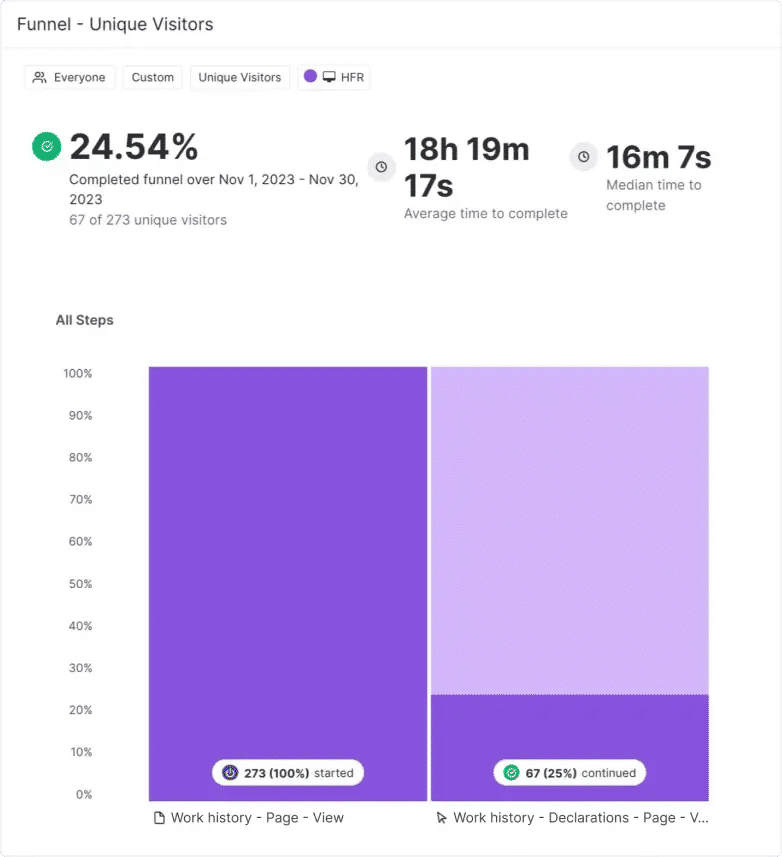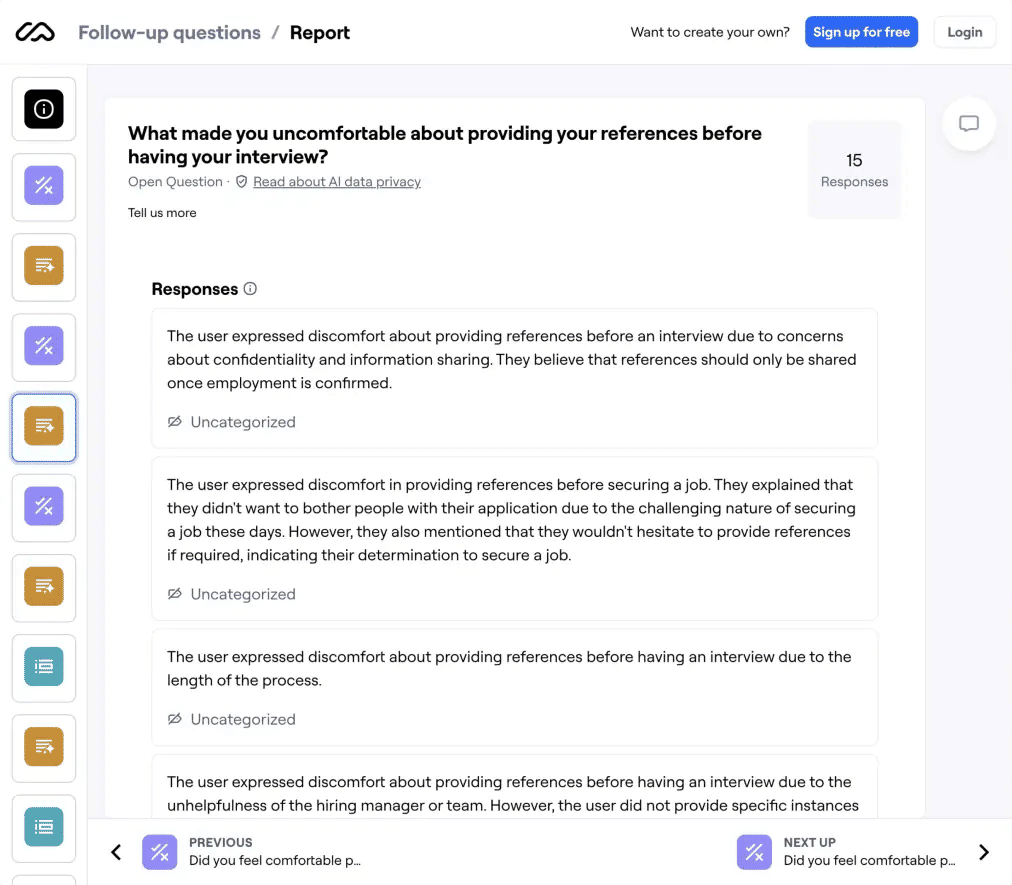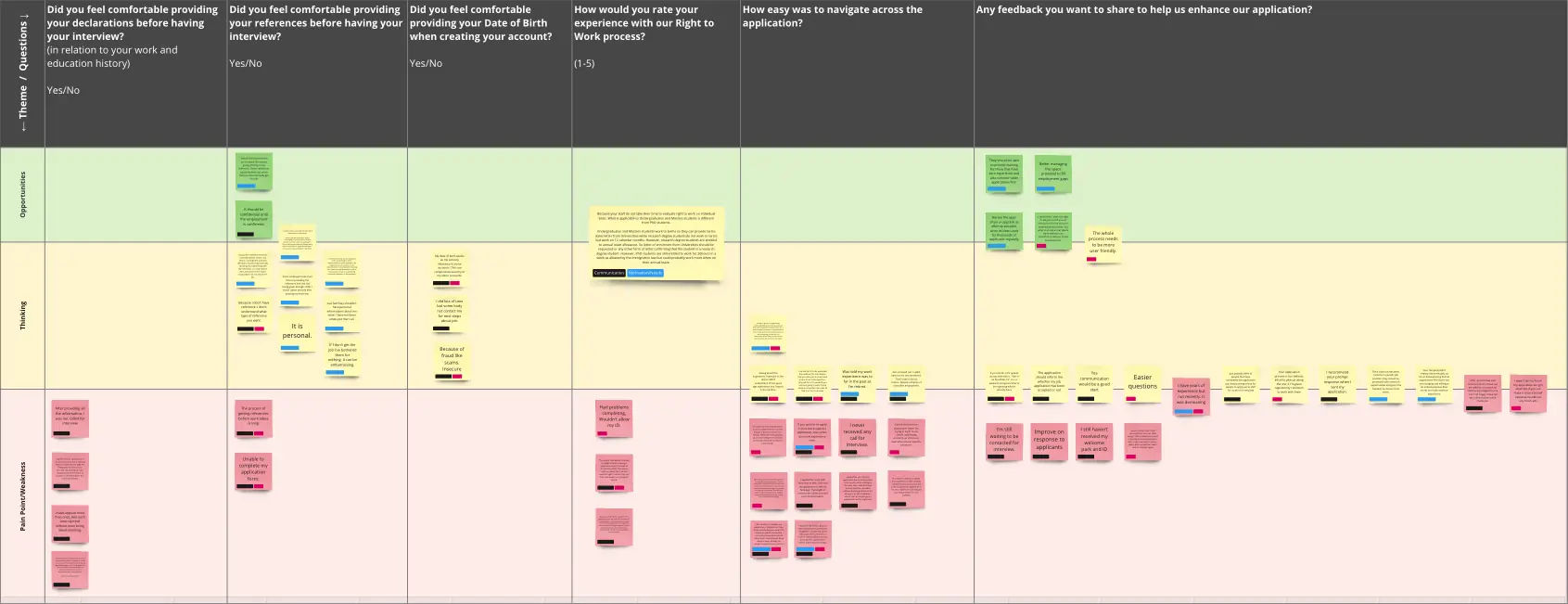Recruitment application

Recruitment application is at the forefront of Newcross Healthcare's operations. Vetting and hiring candidates can be very monotonous and challenging, as every candidate originates from a diverse background, accommodating each one can be difficult. I was assigned to optimise the recruitment process by enhancing the overall user experience through conducting a heuristic evaluation, utilising user research and analytics.
Goals
Working collaboratively with project managers on our Q2 and Q3 objectives was to:
- Increase the first-stage application conversion rate by 150%.
- Raise the completion rate from 'Registration' to 'Work history' from 65% to 75%.
- Decrease the number of applicants routed to the wrong 'Right to work' flow by 30%.
- Shorten the time required to schedule interviews by 25%.
- Increase the number of candidates scheduling interviews.
- Enhance in-app self-service support and decrease the number of queries from the central recruitment team.
- Gradually introduce the design system to enhance applicants' experience, brand perception, and impression.
Results
Utilising a combination of user research and analytics, we've achieved the following results:
- Converted 311% more candidates than before in the first stage of the application.
- Increased the completion rate from 65% to 94% registration to work history page.
- Initial decrease in the number of applicants by going the wrong flow by 20%, ongoing improvements.
- Reduced the time to book an interview from 5 days to an average of 2.3 days (74% reduction).
- Increased the weekly average of booked interviews from 2 to 7, ~150% increase in monthly booked interviews on average.
- Decreased the amount of queries to central recruitment team regarding by 25%.
- Progressively introduced the design system, and reduced time to build/iterate on the recruitment project.
Inheriting the designs and flows
Shortly I've joined Newcross I was inheriting designs that were making into production (the project was called OAE - Online Application Experience). A lot of this was built with business in mind first, driven by the back-end/tech implementation, requirements from the recruitment team. I had to balance working on the scoped and planned features (without implementing any major changes) and building research cases in the background.

Began by creating a journey map to understand the recruitment process at a high level...


Research
Usability test
In between building the flows, constructing the hypotheses, and delivering the legacy designs for the already scoped features, I've launched the usability test on Maze (with Figma prototype), covering Stages one and two of the application process.


Findings from the usability test
From our test, and as stated in my hypotheses we've discovered that:
- Overall, screens were busy, with a lot of text, and some of the sections were confusing.
- Work history was one of the most difficult ones to complete; things like providing reasons for leaving the job or providing a statement of events.
- When asking candidates to provide the documents, the upload list should be ordered from the most popular to the least popular ones.
- By analysing the heatmaps, it was not always clear which UI elements were interactive (clickable), testers tried to click on the static UI elements.
Analytics
Shortly after completing the usability study, we tweaked some of the pages and launched the recruitment application. These changes were minimal, as the features had already been scoped for the sprints and were being tested by the Quality Assurance department. I have progressively started to implement analytics (we have used Heap and moved to Pendo), track events, build segments, and funnels among others.

Findings from the analytics
Through analytics, we've identified the following issues:
- Candidates re-upload their CVs due to warnings prompting them to fill out remaining information (such as reason for leaving), thinking their CV didn't parse correctly the first time.
- We don't convert many applicants, as we allow account creation before screening for minimum healthcare experience required for Newcross.
- We fail to communicate clearly that we only accept UK healthcare experience on the Work History page.
- The References page has a high rate of incomplete submissions.
- Applicants are often directed to the wrong Right To Work flow.

Questionnaire
By combining usability testing and analytics, we've already begun to paint a clearer picture of what to focus on next. At this stage, we have an excellent opportunity to reach out to the candidates who did not complete the application process and dropped off at various stages - we've sent out a follow-up questionnaire to these applicants.

From the questionnaire, we've deduced the following:
- Candidates were hesitant to provide references before the interview stage with Newcross.
- Some candidates who applied for multiple roles did not receive any follow-up communication from Newcross.
- The application process was perceived as excessively lengthy, taking weeks to process and communicate updates.
- The Right To Work page presented issues, preventing some applicants from completing their applications.
- The CV upload page caused confusion, as it requested applicants to edit information they deemed redundant.

New flows and designs
Writing in progress...